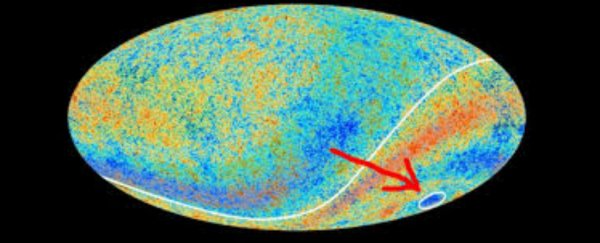Astronomers have stumbled across the biggest object ever detected in the Universe… and it's a void that stretches for 1.8 billion light years.
Distinguishable by its emptiness, the 'supervoid', as it's being called, isn't the only hole in the Universe, but it's the biggest patch we've found, and is abnormal in the typically evenly distributed Universe.
The supervoid was spotted by scientists trying to explain an unusually cool patch in the radiation left over from the Big Bang, known as the Universe's cosmic microwave background. You can see this patch, which researchers named the 'Cold Spot', circled in the image above, taken by the European Space Agency's (ESA) Planck telescope.
For the past decade, researchers have been extremely interested in the Cold Spot, because it doesn't fit with our current understanding of how the Universe evolved. While a few small warm and cold patches are expected, we shouldn't see such big cold patches, according to the current model.
So an international team of astronomers decided to investigate further, and stumbled across the hole. Although the void isn't entirely empty, there are an estimated 10,000 galaxies missing from the patch of sky.
Previous studies had missed the supervoid as they were looking too far back - the researchers used the Pan-STARRS1 telescope in Hawaii, and NASA's Wide Field Survey Explorer to count the number of galaxies in a patch of sky just 3 billion light years away.
"This is the greatest supervoid ever discovered," one of the researchers András Kovács, from the Eötvös Loránd University in Budapest, told Hannah Devlin over at The Guardian. "In combination of size and emptiness, our supervoid is still a very rare event. We can only expect a few supervoids this big in the observable universe."
The supervoid isn't actually a vacuum, but because it's so sparse - it contains around 20 percent less matter than the rest of the Universe - it sucks energy from light travelling through it, partially contributing to the Cold Spot's unusually low temperature.
But, frustratingly, it still doesn't fully explain why that region of the sky is so cold.
"The void itself I'm not so unhappy about. It's like the Everest of voids – there has to be one that's bigger than the rest," Carlos Frenk, a cosmologist from the University of Durham in the UK, who wasn't involved in the research, told Devlin. "But it doesn't explain the whole Cold Spot, which we're still in the dark about."
The one thing the slow-down of light as it passes through the supervoid does support, however, is the fact that the Universe is expanding at an accelerating rate. As Devlin explains:
"This is because the photons convert kinetic energy to gravitational potential as they travel to the heart of the void and get further from denser surrounding patches of universe - think of it as climbing a hill. In a stationary universe, the situation would be symmetrical and so the photons would regain the lost energy on the way out of the void (down the hill) and exit at the same speed.
In an accelerated expansion of the universe, however, everything is effectively becoming less dense as space is stretched out, so voids become relatively shallower over time. This means by the time the light descends the virtual hill, the hill has become flatter and the light cannot pick up all the speed it lost on the way in."
So if you weren't already feeling like the Universe was a cold, lonely place, don't worry, there are now holes out there thousands of times bigger than our entire galaxy.
Source: The Guardian

